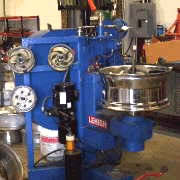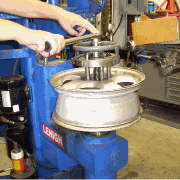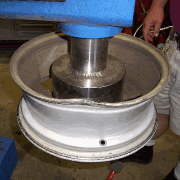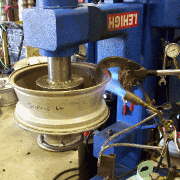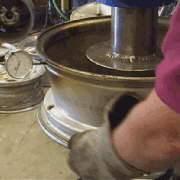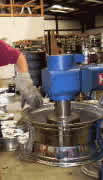Our Wheel Straightening and Repair Process
Received wheels are first checked for circumference (roundness) and lateral (side to side) damage with a dial indicator. Once determined the wheel is not bent out of perpendicular plane with the spindle it can then be evaluated for repair. This evaluation includes checking for the existence of cracks that may have been overlooked up to this point by the wheel owner. Once the evaluation is complete a phone call is made or email is sent to the owner for authorization to continue and once granted the wheel proceeds to straightening.
First, wheels are tightly torqued through the lug seats after centering the wheel on the precision head and variable centering collet. This insures the measurements of the finished repair can be accurately duplicated down the line at the tire balancing equipment and ultimately to being straight on the vehicle’s hub or spindle.
Then if necessary the wheel is flipped on the straightening machine to place the damaged portion of the wheel up for easy access. We work with each side of the wheel until it is true. While this particular wheel is only damaged on one side, were it damaged on the other, after it is allowed to cool and we equalized strains and stresses with an operation we call “ringing out,” the process would be repeated on the other flange. Because of high heat, face bends that are painted and not chrome plated will burn and discolor in the area to be straightened. Face bends on other than chrome plated wheels generally are going to require a full refinishing and the basic straightening pricing below will not apply.
Wheels are gently heated in the areas to be worked to that critical “sweet spot” that allows the metal to be worked, while staying below the melting point. The softened metal at the bent point of the wheel is moved slowly back to the normal arc. Care is taken not to overheat the alloy. Our years of experience have taught us how to recognize and deal with the nuances of working with the forged and various qualities of cast wheels used in production today. The hydraulic ram is used with the appropriate custom straightening dies to slowly bring the bend back to the original specifications.
Each heating and moving process is followed by a check of the progress of the repair with a precision dial micrometer. Most bends are returned to a maximum circumference run-out of less than .030” (30/1000 inch.) Typical run-outs of a repaired wheel are between .015” and .020” inch. We have found over the years that new OEM wheels in the box have a nominal run-out of .010” – .020” and our typical results are within the approximate thickness of a sheet of writing paper of the nominal tolerance of a new wheel.
Though only one bend may be originally apparent, sympathetic collisions of impact forces create strain binds in the circumference of the wheel. Controlled heating and cooling of these impact and non-impact areas and subsequent ringing out of the wheel strain created by the push of the distortion in the original impact bend equalizes the distortions and as the wheel cools it anneals (hardens) and is as strong as ever.

